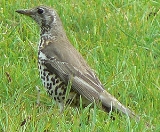
Mistle Thrush
Encyclopedia
- Mistle redirects here: distinguish from missileMissileThough a missile may be any thrown or launched object, it colloquially almost always refers to a self-propelled guided weapon system.-Etymology:The word missile comes from the Latin verb mittere, meaning "to send"...
and missalMissalA missal is a liturgical book containing all instructions and texts necessary for the celebration of Mass throughout the year.-History:Before the compilation of such books, several books were used when celebrating Mass...
.
The Mistle Thrush (Turdus viscivorus) is a member of the thrush
Thrush (bird)
The thrushes, family Turdidae, are a group of passerine birds that occur worldwide.-Characteristics:Thrushes are plump, soft-plumaged, small to medium-sized birds, inhabiting wooded areas, and often feed on the ground or eat small fruit. The smallest thrush may be the Forest Rock-thrush, at and...
family Turdidae.
It is found in open woods and cultivated land over all of Europe and much of Asia
Asia
Asia is the world's largest and most populous continent, located primarily in the eastern and northern hemispheres. It covers 8.7% of the Earth's total surface area and with approximately 3.879 billion people, it hosts 60% of the world's current human population...
. Many northern birds move south during the winter, with migrating
Bird migration
Bird migration is the regular seasonal journey undertaken by many species of birds. Bird movements include those made in response to changes in food availability, habitat or weather. Sometimes, journeys are not termed "true migration" because they are irregular or in only one direction...
birds sometimes forming small flocks.
Taxonomy
This species was first described by LinnaeusCarolus Linnaeus
Carl Linnaeus , also known after his ennoblement as , was a Swedish botanist, physician, and zoologist, who laid the foundations for the modern scheme of binomial nomenclature. He is known as the father of modern taxonomy, and is also considered one of the fathers of modern ecology...
in his Systema naturae in 1758 under its current scientific name. The English
English language
English is a West Germanic language that arose in the Anglo-Saxon kingdoms of England and spread into what was to become south-east Scotland under the influence of the Anglian medieval kingdom of Northumbria...
name refers to its mistletoe eating, as does the scientific
Binomial nomenclature
Binomial nomenclature is a formal system of naming species of living things by giving each a name composed of two parts, both of which use Latin grammatical forms, although they can be based on words from other languages...
name, which is derived from the Latin
Latin
Latin is an Italic language originally spoken in Latium and Ancient Rome. It, along with most European languages, is a descendant of the ancient Proto-Indo-European language. Although it is considered a dead language, a number of scholars and members of the Christian clergy speak it fluently, and...
words Turdus, "thrush", and viscivorus meaning "mistletoe eater".
A recent molecular study places the Mistle Thrush's closest relatives as the similarly plumaged Song Thrush
Song Thrush
The Song Thrush is a thrush that breeds across much of Eurasia. It is also known in English dialects as throstle or mavis. It has brown upperparts and black-spotted cream or buff underparts and has three recognised subspecies...
(T. philomelos) and the Chinese Thrush
Chinese Thrush
The Chinese Thrush is a species of bird in the Turdidae family.It is found in China and Vietnam.Its natural habitats are temperate forests and subtropical or tropical moist montanes....
(T. mupinensis), all three species early offshoots from the main Turdus radiation around the world, and hence only distantly related to other European species such as the Common Blackbird (T. merula).
Description
The Mistle Thrush averages about 27 cm long, larger than the similar Song ThrushSong Thrush
The Song Thrush is a thrush that breeds across much of Eurasia. It is also known in English dialects as throstle or mavis. It has brown upperparts and black-spotted cream or buff underparts and has three recognised subspecies...
. The sexes are similar, with plain greyish brown backs and neatly round-spotted underparts. The breast has much less buff than the Song Thrush
Song Thrush
The Song Thrush is a thrush that breeds across much of Eurasia. It is also known in English dialects as throstle or mavis. It has brown upperparts and black-spotted cream or buff underparts and has three recognised subspecies...
.
Behaviour
Voice
The male sings its loud melodious song from a tree, rooftop or other elevated perch, often during bad weather or at night, and starting relatively early in the spring — hence the Mistle Thrush's old name of "Stormcock". The song is like a harder and simpler version of the Blackbird's. The alarm call is said to sound like a football rattle (a form of musical ratchetRatchet (instrument)
A ratchet, also called a noisemaker , is an orchestral musical instrument played by percussionists. Operating on the principle of the ratchet device, a gearwheel and a stiff board is mounted on a handle, which can be freely rotated...
) or machine gun.
Diet
It is omnivorous, eating insects, worms and berries. A Mistle Thrush will defend a berry-bearing tree against other thrushes in winter. MistletoeViscum album
Viscum album is a species of mistletoe, the species originally so-named, and also known as European Mistletoe or Common Mistletoe to distinguish it from other related species...
berries are amongst its diet.
Breeding
They nest in trees, laying several eggsEgg (biology)
An egg is an organic vessel in which an embryo first begins to develop. In most birds, reptiles, insects, molluscs, fish, and monotremes, an egg is the zygote, resulting from fertilization of the ovum, which is expelled from the body and permitted to develop outside the body until the developing...
in a neat cup-shaped nest lined with grass.
Further reading
- Snow, B.K. & Snow, D.W. (1984). "Long-term defence of fruit by Mistle Thrushes Turdus viscivorus. Ibis 126(1):39-49

